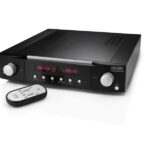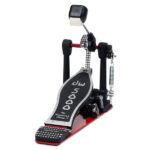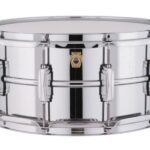When it comes to professional audio recording, choosing the right microphone is crucial.
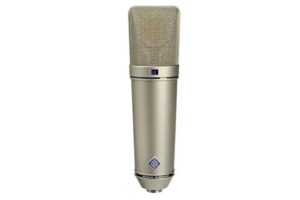
The U87 and TLM 103 are two popular options often considered by professionals in the industry.
These microphones are reliable tools for capturing high-quality sound and are widely used in studios worldwide.
This article will compare the U87 and TLM 103 in various aspects to help you decide based on your specific needs.
We will explore their design, sound quality, frequency response, and polar patterns.
We aim to provide you with a clear understanding of the strengths and differences between these two microphones.
Contents
Overview of U87 Ai
The U87, a renowned condenser microphone by Neumann, has been a staple in the recording industry for decades.
Its exceptional sound quality and versatility have gained widespread recognition among professionals worldwide.
Featuring a large-diaphragm design, the U87 delivers a warm and rich sound reproduction that precisely captures the nuances of audio.
Its three selectable polar patterns—cardioid, omnidirectional, and figure-8—provide flexibility for various recording scenarios.
The cardioid pattern isolates sound sources, the omnidirectional pattern captures room ambiance, and the figure-8 pattern is ideal for recording duets.
The U87’s wide frequency response from 20Hz to 20kHz ensures the accurate reproduction of diverse instruments and vocals.
Its robust build, including a metal grille and matte nickel finish, signifies durability and professionalism.
Overview of TLM 103
The TLM 103, a condenser microphone manufactured by Neumann, is renowned for its transparent and accurate sound reproduction.
Its fixed cardioid polar pattern excels at capturing sound directly in front of the microphone.
At the same time effectively rejecting unwanted noise from the sides and rear. It is popular for vocal recordings, voiceovers, and precise acoustic instrument capturing.
The TLM 103 offers a detailed and accurate frequency response, ranging from 20Hz to 20kHz.
Its ability to faithfully reproduce the subtle nuances and transient responses of various instruments and vocals is highly regarded.
With low self-noise levels and high sensitivity, the TLM 103 ensures clean and clear recordings even in quiet environments.
Its sleek design, compact and lightweight body, and durable construction make it a reliable tool for professional use.
Comparison Between U87 Ai and TLM 103
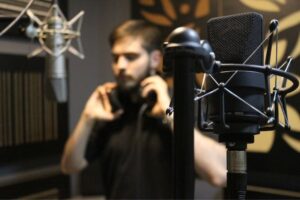
Here is the comprehensive comparison of U87 and TLM 103:
Design and Build Quality
The U87 Ai and TLM 103 exhibit impressive design and build quality. It reflects the meticulous craftsmanship and attention to detail for which Neumann is renowned.
Starting with the U87, this microphone features a classic design that has stood the test of time. It showcases a robust construction with a metal grille and a sleek matte nickel finish.
The U87’s Ai iconic look instantly evokes a sense of professionalism and reliability. Its substantial weight adds to the perception of durability and quality.
Similarly, the TLM 103 boasts an elegant and streamlined design. Its compact and lightweight body makes it easy to handle and position during recording sessions.
The microphone’s construction is sturdy, ensuring its ability to withstand the rigors of professional use. The TLM 103 exudes a sense of modernity while maintaining a timeless aesthetic.
Both microphones are built to withstand the demands of the recording environment.
They are designed to minimize the transmission of unwanted vibrations, resulting in improved isolation and reduced handling noise.
This feature is significant when capturing delicate performances or working in a studio with multiple microphones nearby.
The design’s attention to detail extends to the microphones’ control layout. The U87 offers switches for polar pattern selection and a high-pass filter.
It allows quick adjustments to adapt to different recording scenarios. On the other hand, the TLM 103 features a fixed cardioid polar pattern.
It simplifies operations by eliminating the need for pattern adjustments.
Sound Quality
The U87 Ai and TLM 103 are renowned for their exceptional sound quality.
They offer professional-grade audio reproduction that captures the nuances and subtleties of the recorded source.
The U87 Ai microphone is celebrated for its warm and rich sound signature.
It exhibits a well-balanced frequency response that accurately reproduces various instruments and vocals.
The U87’s large-diaphragm design contributes to its ability to capture a broad spectrum of frequencies with clarity and precision.
Its midrange boost adds a pleasing warmth and presence to recordings. It makes it a favored choice for vocals, acoustic instruments, and drum overheads.
Similarly, the TLM 103 excels in delivering transparent and accurate sound reproduction.
It offers a detailed frequency response that faithfully captures the original sonic characteristics of the source material.
The TLM 103’s precise transient response ensures that even the most subtle nuances are captured with clarity and fidelity.
Low self-noise and high sensitivity can capture delicate performances and quiet sounds without introducing unwanted artifacts.
Frequency Response

The frequency response of a microphone determines its tonal balance and the range of frequencies it can capture.
The U87 Ai has a frequency response of 20Hz to 20kHz, providing a balanced representation of the audio spectrum.
It slightly boosts in the midrange, adding warmth and presence to recordings. On the other hand, the TLM 103 has a flatter frequency response.
It accurately captures audio across the entire spectrum without emphasizing any particular frequency range.
Polar Pattern
Polar patterns determine the microphone’s sensitivity to sound coming from different directions.
The U87 Ai condenser offers three selectable polar patterns, making it versatile for various recording scenarios.
The cardioid pattern is commonly used for isolating sound sources.
While the omnidirectional and figure-8 patterns are ideal for capturing room ambiance and recording multiple good sources simultaneously.
The TLM 103 fixed cardioid polar pattern is designed to focus on the sound directly in front of it. It makes it suitable for vocal recordings and close-miking applications.
Sensitivity and Self-Noise
A microphone’s sensitivity and self-noise levels are essential considerations, especially in recording quiet sources.
The U87 has a higher sensitivity and lower self-noise than the TLM 103. It can capture subtle details and quiet performances with precision.
The TLM 103, with its lower sensitivity and slightly higher self-noise, can still deliver clean recordings with minimal background noise.
Applications
Both the U87 and TLM 103 find their applications in various recording scenarios.
The U87’s versatility suits it for studio recording, broadcasts, podcasts, and live performances. It excels in capturing vocals, acoustic instruments, drums, and more.
The TLM 103’s transparent sound and detailed response are often favored for professional vocal recordings. Also, for voiceovers, and acoustic instruments where accuracy is paramount.
Price Comparison
In terms of pricing, the U87 is generally more expensive than the TLM 103. The U87’s legendary status and versatility contribute to its higher price tag.
However, the TLM 103 offers exceptional performance at a more affordable price point. It makes it an attractive option for those with a tighter budget.
Pros and Cons
Here are the pros and cons of U87 and TLM 103:
U87 Pros:
- Versatile with three selectable polar patterns.
- Warm and smooth sound reproduction.
- Excellent build quality and durability.
U87 Cons:
- Higher price point.
- Relatively heavy.
TLM 103 Pros:
- Transparent and accurate sound reproduction.
- Affordable compared to the U87.
- Lightweight and portable design.
TLM 103 Cons:
- Fixed cardioid polar pattern.
- Less versatile compared to the U87.
Conclusion
The U87 and TLM 103 comparison reveals two exceptional condenser microphones that have solidified their positions as industry favorites.
Both microphones offer distinct features and qualities that cater to different recording needs and preferences.
The U87 stands out with its legendary status, versatile polar patterns, and warm sound signature.
On the other hand, the TLM 103 impresses with its transparent and accurate sound reproduction, compact design, and excellent transient response.
Ultimately, the choice between the U87 and TLM 103 depends on individual requirements and preferences.
Whether seeking a classic and versatile microphone or a modern and precise option, both microphones offer exceptional sound quality and performance.
It enables professionals to achieve outstanding recordings in their respective fields.

